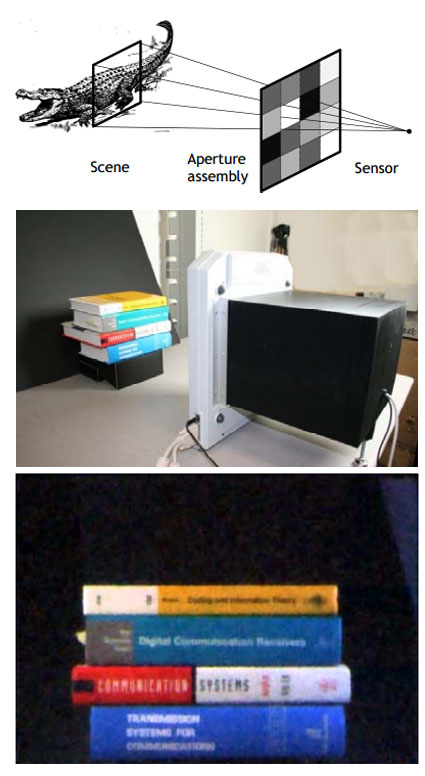Bell Labs Invents Lensless Camera
The traditional method of imaging, which is at least 150 years old, relies on a lens to create an image and a device for recording photons such as an array of pixels, a light-sensitive film or even a retina.

But a dramatic revolution that is currently taking the world of imaging by storm means that this could soon change.
This revolution is based on a technique called compressive sensing, which is based on the idea that many common measurements have huge redundancy. That means it’s possible to acquire the same data with just a fraction of carefully chosen measurements.
The trick, of course, is knowing which measurements to take and how to reassemble them. Various teams have been excitedly experimenting with this idea. Back in January, for example, we looked at one group who have created 3-D images using a single pixel in this way.
Today, this revolution gains pace because Gang Huang and pals from Bell Labs in New Jersey say they’ve used compressive sensing to build a camera that needs no lens and uses only a single sensing pixel to take photographs. What’s more, the images from this camera are never out of focus.
The new device is simple in nature. “The architecture consists of two components, an aperture assembly and a sensor. No lens is used,” say Huang and co. It consists of an LCD panel that acts as an array of apertures that each allow light to pass through and a single sensor capable of detecting light three colours.
Each aperture in the LCD array is individually addressable and so can be open to allow light to pass through or closed. An important aspect of this kind of imaging is that the array of open and closed apertures must be random.
The process of creating an image is straightforward. It begins with the sensor recording the light from the scene that has passed through a random array of apertures in the LCD panel. It then records the light from a different random array and then another and so on.
Although seemingly random, each of these snapshots is correlated because they record the same scene in a different way. And this is the key that the team use to reassemble an image. The process of compressive sensing analyses the data, looking for this correlation which it then uses to recreate the image.
Clearly, the more snapshots that are taken, the better the image will be. But it is possible to create a pretty good image using just a tiny fraction of the data that a conventional image would require.
For example, the Bell Labs team took the image of the books (above) using only a quarter of the data they could have recorded.
In fact, the less detail there is in the scene, the less data is required to reconstruct it.
This revolutionary lensless camera has a number of advantages over a conventional camera. First is the tiny amount of data required to create images. Without a lens, these images suffer none of the aberrations and focusing problems associated with lenses. The scene is entirely in focus and the resolution of the image depends on the size and number of the apertures and the point-like nature of the light sensor.
By using two sensors behind the same aperture array, it is possible to create two different images of the scene at the same time. Indeed, multiple sensors produce multiple images.
What’s more, the device is simple and cheap. Huang and pals built their prototype using cheap off-the-shelf components that anybody would have access to.
Best of all, the same approach works for other wavelength of light such as infrared and millimetre waves. So it ought to be possible to create relatively cheap cameras for these wavelengths too.
The disadvantage, at least for the moment, is that it takes time to acquire the data for each image. So the camera only creates images of still scenes.
But even that is useful for surveillance since it is possible to compare consecutive images of the same scene to determine things that have changed or to work out the speed of moving objects.
That’s an impressive piece of work that is likely to have far-reaching consequences for the way we record the world around us. Expect to hear a lot more about compressive imaging, or ghost imaging as it is sometimes called, in the near future.
It’s also interesting to see Bell Labs hitting its straps again. This is an organisation with a venerable history but a tumultuous recent past. With advances like this, there is always the chance it can recapture some of its former glory.
Ref: arxiv.org/abs/1305.7181: Lensless Imaging By Compressive Sensing
Keep Reading
Most Popular
Large language models can do jaw-dropping things. But nobody knows exactly why.
And that's a problem. Figuring it out is one of the biggest scientific puzzles of our time and a crucial step towards controlling more powerful future models.
How scientists traced a mysterious covid case back to six toilets
When wastewater surveillance turns into a hunt for a single infected individual, the ethics get tricky.
The problem with plug-in hybrids? Their drivers.
Plug-in hybrids are often sold as a transition to EVs, but new data from Europe shows we’re still underestimating the emissions they produce.
Google DeepMind’s new generative model makes Super Mario–like games from scratch
Genie learns how to control games by watching hours and hours of video. It could help train next-gen robots too.
Stay connected
Get the latest updates from
MIT Technology Review
Discover special offers, top stories, upcoming events, and more.